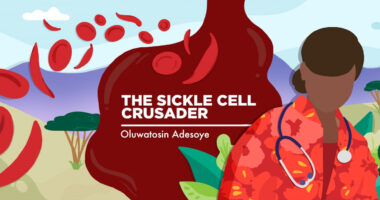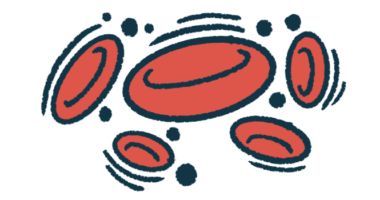Most SCD patients given Lyfgenia in trials stay free of VOEs: New data
Findings show gene therapy’s potential to 'permanently address' disease cause

The vast majority of people with sickle cell disease (SCD) who received the now-approved gene therapy Lyfgenia (lovotibeglogene autotemcel) in clinical trials have been free from vaso-occlusive events — simply called VOEs — in the years following treatment.
That’s according to new data that Lyfgenia’s developer Bluebird Bio showcased in an oral presentation at the 66th American Society of Hematology (ASH) Annual Meeting and Exposition, held Dec. 7-10 in San Diego.
Specifically, more than 85% of patients who could be evaluated had complete resolution of VOEs, maintained for a median of more than 42 months, or 3.5 years, Bluebird stated in a company press release. Further, “10/10 (100%) pediatric patients achieved complete resolution of VOEs,” per the release.
According to Richard Colvin, MD, PhD, Bluebird’s chief medical officer, “these data continue to distinguish Lyfgenia as the most deeply studied gene therapy for sickle cell disease, with the most patients treated, longest follow-up, and broadest range of clinical presentations evaluated across the field.”
The presentation was titled “An Update on Lovotibeglogene Autotemcel (Lovo-cel) Clinical Trials for Sickle Cell Disease (SCD) and Analysis of Early Predictors of Response to Lovo-Cel.”
Over 85% of Lyfenia-treated patients remained free of VOEs after 3.5 years
Sickle cell is caused by mutations in a gene needed to produce hemoglobin, the protein that red blood cells use to carry oxygen through the bloodstream. The abnormal hemoglobin clumps up inside red blood cells, deforming them into the sickle shape that gives SCD its name. The deformed red blood cells are prone to getting trapped inside blood vessels and blocking blood flow, leading to painful vaso-occlusive crises and other vaso-occlusive events.
Lyfgenia is an approved gene therapy that works to deliver a gene into a patient’s blood stem cells that carries instructions to make a sickling-resistant version of hemoglobin. The therapy involves collecting blood stem cells from a patient’s bone marrow, modifying them in a lab, and then returning them via a stem cell transplant so they can repopulate the body with new blood cells carrying the therapeutic gene.
This approach enables the red blood cells that are created from the engineered stem cells to be resistant to sickling, which in turn is expected to reduce the frequency of VOEs.
The new data now presented by the company covered 58 people with SCD who took part in the Phase 1/2 HGB-206 clinical trial (NCT02140554) or the Phase 3 HGB-210 clinical trial (NCT04293185).
All of the patients in the analysis received Lyfgenia treatment using the process that’s now used to make the commercially available therapy. The median follow-up time for these patients was nearly four years, with 15 individuals having been followed for five years or more.
“The number of patients treated, and duration of follow-up, has enabled detailed exploration of the pharmacology and mechanism of action of … gene therapy for sickle cell disease, providing even greater support that one-time treatment with [Lyfgenia] has the potential to permanently address the underlying cause of sickle cell disease,” said Stacey Rifkin-Zenenberg, a hematologist-oncologist from Hackensack Meridian Health in New Jersey.
These data demonstrate that the significant clinical benefits of [Lyfgenia] for people living with sickle cell disease are durable through continued long-term follow-up.
As of the most recent follow-up, all patients were producing the sickling-resistant version of hemoglobin, and average hemoglobin levels were within a normal range without the need for blood transfusions.
“These data demonstrate that the significant clinical benefits of [Lyfgenia] for people living with sickle cell disease are durable through continued long-term follow-up,” Rifkin-Zenenberg said.
In the analysis were 38 patients who could be evaluated for VOEs — these individuals had been followed for at least 18 months, or 1.5 years, and had experienced at least four VOEs in the two years prior to entering the trial. With a median follow-up of more than 3.5 years since receiving Lyfgenia, all but five of these patients — 33 individuals or 86.8% — had been completely free from VOEs, and all but two had no severe vaso-occlusive events.
The presentation noted that all 10 children or adolescents who received Lyfgenia have been completely free from VOEs, including severe events, as of the latest follow-up.
“One-time [Lyfgenia] treatment results in sustained [sickling-resistant hemoglobin] production and eliminated VOEs and [severe] VOEs in a majority of participants,” the researchers wrote.
Data also show no reports of stroke for SCD patients treated with Lyfgenia
The therapy’s safety profile was generally consistent with SCD and the known effects of conditioning regimens used before a stem cell transplant, according to the new data.
One of the most serious complications of SCD is stroke, which happens when blood flow to the brain is disrupted. In a separate poster presentation at the ASH meeting, researchers used data from the Phase 1/2 HGB-206 trial to evaluate how Lyfgenia affects stroke risk in patients with a history of stroke. That poster was titled “Participants with a History of Stroke in Lovotibeglogene Autotemcel (Lovo-cel) Clinical Trials.”
Jennifer Jaroscak, MD, director of the pediatric nonmalignant transplant at the Medical University of South Carolina and the study’s presenting author, said “these data are unique in the field as [Lyfgenia] is the only gene therapy for sickle cell disease with data on patients with a history of stroke.”
Before treatment with Lyfgenia, six of the study participants had a history of overt stroke, that is, a stroke that causes obvious symptoms. Another 21 patients had previously experienced a silent stroke, where damage is visible on MRI scans of the brain, but no obvious symptoms are present.
According to the data, with a median follow-up time of as long as 6.5 years, there have so far been no reports of stroke in patients following treatment with Lyfgenia.
“We are extremely pleased to report that no study participants with a history of overt or silent stroke experienced recurrent strokes following treatment with [Lyfgenia] gene therapy, despite discontinuing transfusions,” Jaroscak said. “This finding is remarkable, as these patients face an exceedingly high risk of subsequent strokes, and transfusions alone provide only modest protection against secondary strokes.”








